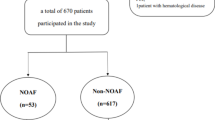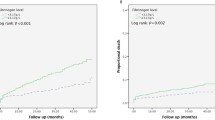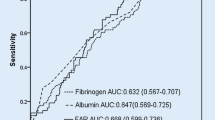Abstract
Plasma fibrinogen levels influence restenosis following elective percutaneous coronary intervention (PCI) for stable angina. It is unknown whether the same is true in the setting of primary PCI. The aim of the study was therefore to assess whether fibrinogen levels were associated to 6-month in-stent restenosis (ISR) in STEMI patients undergoing successful primary PCI. From January 2003 to October 2004, 267 patients were admitted to our Institution for STEMI and treated by primary PCI. Of these, 171 patients met the inclusion criteria and were enrolled in our study. Fibrinogen levels were assessed at admission, 12 h, 24 h, 48 h, 72 h following PCI and at discharge. Six-month angiographic follow-up was 100% complete. Subjects with 6-month ISR showed higher fibrinogen levels than patients without ISR. Patients in the upper fibrinogen tertile showed a higher 6-month incidence of symptoms and/or inducible myocardial ischemia (27.1% vs. 7.1%, P = 0.006) and a larger late lumen loss (1.3 ± 0.8 vs. 1.0 ± 0.9 mm, P = 0.049). Logistic regression analysis demonstrated a significant and independent association between fibrinogen levels and ISR. Our study suggests that increased plasma fibrinogen levels are related to ISR in STEMI patients undergoing primary PCI. Larger studies are warranted to assess the prognostic value of fibrinogen over harder end-points.


Similar content being viewed by others
Abbreviations
- PCI:
-
Percutaneous coronary intervention
- STEMI:
-
ST-elevation acute myocardial infarction
- ISR:
-
In-stent restenosis
- IRA:
-
Infarct-related artery
- TLR:
-
Target lesion revascularization
- MLD:
-
Minimal lumen diameter
References
Meade TW, Mellows S, Bronzovic M, Miller GJ, Chakrabarti RR, North WRS, Haines AP, Stirling Y, Imeson JD, Thompson SG (1986) Hemostatic function and ischaemic heart disease: principal results of the Northwick Park Heart Study. Lancet 2:533–537
Kannel WB, Wolf PA, Castelli WP, D’Agostino RB (1987) Fibrinogen and risk of cardiovascular disease: the Framingham Study. JAMA 258:1183–1186
Wilhelmsen L, Svärdsudd K, Korsan-Bengtsen K, Larsson B, Welin L, Tibblin G (1984) Fibrinogen as a risk factor for stroke and myocardial infarction. N Engl J Med 311:501–505
Yarnell JWG, Baker IA, Sweetnam PM, Bainton D, O’Brien JR, Whitehead PJ, Elwood PC (1991) Fibrinogen, viscosity and white blood cell count are major risk factors for ischemic heart disease: the Caerphilly and Speedwell collaborative heart disease studies. Circulation 83:836–844
ECAT angina pectoris study group (1993) ECAT angina pectoris study: baseline associations of haemostatic factors with extent of coronary arteriosclerosis and other coronary risk factors in 3000 patients with angina pectoris undergoing coronary angiography. Eur Heart J 14:8–17
Broadhurst P, Kelleher C, Hughes L, Imeson JD, Raftery EB (1990) Fibrinogen, factor VII clotting activity and coronary artery disease severity. Atherosclerosis 85:169–173
Tschopl M, Tsakiris DA, Marbet GA, Labs KH, Jager K (1997) Role of hemostatic risk factors for restenosis in peripheral arterial occlusive disease after transluminal angioplasty. Arterioscler Thromb Vasc Biol 17:3208–3214
Montalescot G, Ankri A, Vicaut E, Drobinski G, Grosgogeat Y, Thomas D (1995) Fibrinogen after coronary angioplasty as a risk factor for restenosis. Circulation 92:31–38
Rahel M, Visseren FLJ, Suttorp MJ, Plokker THW, Kelder JC, de Jongh BM, Bouter KP, Diepersloot RJA (2003) Preprocedural serum levels of acute-phase reactants and prognosis after percutaneous coronary intervention. Cardiovasc Res 60:136–140
Otsuka M, Hayashi Y, Ueda H, Imazu M, Kohno N (2002) Predictive value of preprocedural fibrinogen concerning coronary stenting. Atherosclerosis 164:371–378
Shammas NW, Shammas G, Bryan D, Rauba J, Dippel E, Jerin M (2009) Predictors of target lesion revascularization in patients undergoing lower extremity percutaneous interventions. J Invasive Cardiol 21:266–269
Wahlgren CM, Sten-Linder M, Egberg N, Kalin B, Blohmé L, Swedenborg J (2006) The role of coagulation and inflammation after angioplasty in patients with peripheral arterial disease. Cardiovasc Intervent Radiol 29:530–535
Thygesen K, Alpert JS, White HD; Joint ESC/ACCF/AHA/WHF Task Force for the Redefinition of Myocardial Infarction, Jaffe AS, Apple FS, Galvani M, Katus HA, Newby LK, Ravkilde J, Chaitman B, Clemmensen PM, Dellborg M, Hod H, Porela P, Underwood R, Bax JJ, Beller GA, Bonow R, Van der Wall EE, Bassand JP, Wijns W, Ferguson TB, Steg PG, Uretsky BF, Williams DO, Armstrong PW, Antman EM, Fox KA, Hamm CW, Ohman EM, Simoons ML, Poole-Wilson PA, Gurfinkel EP, Lopez-Sendon JL, Pais P, Mendis S, Zhu JR, Wallentin LC, Fernández-Avilés F, Fox KM, Parkhomenko AN, Priori SG, Tendera M, Voipio-Pulkki LM, Vahanian A, Camm AJ, De Caterina R, Dean V, Dickstein K, Filippatos G, Funck-Brentano C, Hellemans I, Kristensen SD, McGregor K, Sechtem U, Silber S, Tendera M, Widimsky P, Zamorano JL, Morais J, Brener S, Harrington R, Morrow D, Lim M, Martinez-Rios MA, Steinhubl S, Levine GN, Gibler WB, Goff D, Tubaro M, Dudek D, Al-Attar N (2007) Universal definition of myocardial infarction. Circulation 116:2634–2653.
Clauss A (1957) Gerinnungsphysiologishe Schnellmethode zur Bestimmung des Fibrinogens. Acta Haematol 17:237–246
Cutlip DE, Windecker S, Mehran R, Boam A, Cohen DJ, van Es GA, Steg PG, Morel MA, Mauri L, Vranckx P, McFadden E, Lansky A, Hamon M, Krucoff MW, Serruys PW, for the Academic Research Consortium (2007) Clinical endpoints in coronary stent trials: a case for standardized definitions. Circulation 115:2344–2351
Rits IA (1964) Declaration of Helsinki. Recommendations guidings doctors in clinical research. World Med J 11:281
Danesh J, Lewington S, Thompson SG, Lowe GD, Collins R, Kostis JB, Wilson AC, Folsom AR, Wu K, Benderly M, Goldbourt U, Willeit J, Kiechl S, Yarnell JW, Sweetnam PM, Elwood PC, Cushman M, Psaty BM, Tracy RP, Tybjaerg-Hansen A, Haverkate F, de Maat MP, Fowkes FG, Lee AJ, Smith FB, Salomaa V, Harald K, Rasi R, Vahtera E, Jousilahti P, Pekkanen J, D’Agostino R, Kannel WB, Wilson PW, Tofler G, Arocha-Piñango CL, Rodriguez-Larralde A, Nagy E, Mijares M, Espinosa R, Rodriquez-Roa E, Ryder E, Diez-Ewald MP, Campos G, Fernandez V, Torres E, Marchioli R, Valagussa F, Rosengren A, Wilhelmsen L, Lappas G, Eriksson H, Cremer P, Nagel D, Curb JD, Rodriguez B, Yano K, Salonen JT, Nyyssönen K, Tuomainen TP, Hedblad B, Lind P, Loewel H, Koenig W, Meade TW, Cooper JA, De Stavola B, Knottenbelt C, Miller GJ, Cooper JA, Bauer KA, Rosenberg RD, Sato S, Kitamura A, Naito Y, Palosuo T, Ducimetiere P, Amouyel P, Arveiler D, Evans AE, Ferrieres J, Juhan-Vague I, Bingham A, Schulte H, Assmann G, Cantin B, Lamarche B, Després JP, Dagenais GR, Tunstall-Pedoe H, Woodward M, Ben-Shlomo Y, Davey Smith G, Palmieri V, Yeh JL, Rudnicka A, Ridker P, Rodeghiero F, Tosetto A, Shepherd J, Ford I, Robertson M, Brunner E, Shipley M, Feskens EJ, Kromhout D, Dickinson A, Ireland B, Juzwishin K, Kaptoge S, Lewington S, Memon A, Sarwar N, Walker M, Wheeler J, White I, Wood A (2005) Plasma fibrinogen level and the risk of major cardiovascular diseases and nonvascular mortality: an individual participant meta-analysis (Fibrinogen Studies Collaboration). JAMA 294:1799–1809
Ernst E, Resch KL (1993) Fibrinogen as a cardiovascular risk factor: a meta-analysis and review of the literature. Ann Intern Med 118:956–963
Fibrinogen Studies Collaboration (2004) Collaborative meta-analysis of prospective studies of plasma fibrinogen and cardiovascular disease. Eur J Cardiovasc Prev Rehabil 11:9–17
Handa K, Kono S, Saku K, Sasaki J, Kawano T, Sasaki Y, Hiroki T, Arakawa K (1989) Plasma fibrinogen levels as an independent indicator of severity of coronary atherosclerosis. Atherosclerosis 77:209–213
Badimon L, Badimon JJ, Turitto VT, Vallabhajosula S, Fuster V (1988) Platelet thrombus formation on collagen type I: a model of deep vessel injury: influence of blood rheology, von Willebrand factor, and blood coagulation. Circulation 78:1431–1442
Harker LA (1987) Role of platelets and thrombosis in mechanisms of acute occlusion and restenosis after angioplasty. Am J Cardiol 60:20B–28B
Ip JH, Fuster V, Badimon L, Badimon JJ, Taubman MB, Chesebro JH (1990) Syndromes of accelerated atherosclerosis: role of vascular injury and smooth cell proliferation. J Am Coll Cardiol 15:1667–1687
Shah PK, Amin J (1992) Low high density lipoprotein level is associated with increased restenosis rate after coronary angioplasty. Circulation 85:1279–1285
Schumacher M, Eber B, Tiran A, Toplak H, Luha O, Gasser R, Klein W (1992) Fibrinogen values in patients with and without restenosis following percutaneous transluminal coronary angioplasty. Cardiology 80:345–348
Naito M, Stirk C, Smith E, Thompson W (2000) Smooth muscle cell outgrowth stimulated by fibrin degradation products. The potential role of fibrin E in restenosis and atherogenesis. Thromb Res 98:165–174
Jaster M, Horstkotte D, Willich T, Stellbaum C, Knie W, Spencker S, Pauschinger M, Schultheiss HP, Rauch U (2008) The amount of fibrinogen-positive platelets predicts the occurrence of in-stent restenosis. Atherosclerosis 197:190–196
Kamath S, Lip GY (2003) Fibrinogen: biochemistry, epidemiology and determinants. QJM 96:711–729
Rosenson RS (1993) Myocardial injury: the acute phase response and lipoprotein metabolism. J Am Coll Cardiol 22:933–940
Reinhart WH (2003) Fibrinogen: marker or mediator of vascular disease? Vasc Med 8:211–216
The Fibrinogen Studies Collaboration (2007) Associations of plasma fibrinogen levels with established cardiovascular disease risk factors, inflammatory markers, and other characteristics: individual participant meta-analysis of 154, 211 adults in 31 prospective studies. Am J Epidemiol 166:867–879
Ørn S, Manhenke C, Ueland T, Damås JK, Mollnes TE, Edvardsen T, Aukrust P, Dickstein K (2009) C-reactive protein, infarct size, microvascular obstruction, and left-ventricular remodelling following acute myocardial infarction. Eur Heart J 30:1180–1186
Harjai KJ, Grines C, Stone GW, Boura J, Turco M, Brodie B, Sadeghi HM, Cox D, Grines L, O’ Neill WW (2003) Frequency, determinants, and clinical implications of residual intracoronary thrombus following primary angioplasty for acute myocardial infarction. Am J Cardiol 92:377–382
Buffon A, Liuzzo G, Biasucci LM, Pasqualetti P, Ramazzotti V, Rebuzzi AG, Crea F, Maseri A (1999) Preprocedural serum levels of C-reactive protein predict early complications and late restenosis after coronary angioplasty. J Am Coll Cardiol 34:1512–1521
Ferrante G, Niccoli G, Biasucci LM, Liuzzo G, Burzotta F, Galiuto L, Trani C, Rebuzzi AG, Crea F (2008) Association between C-reactive protein and angiographic restenosis after bare metal stents: an updated and comprehensive meta-analysis of 2747 patients. Cardiovasc Revasc Med 9:156–165
Ferns GA, Avades TY (2000) The mechanisms of coronary restenosis: insights from experimental models. Int J Exp Pathol 81:63–88
Hoffmann R, Mintz GS (2000) Coronary in-stent restenosis: predictors, treatment and prevention. Eur Heart J 21:1739–1749
Author information
Authors and Affiliations
Corresponding author
Rights and permissions
About this article
Cite this article
Lupi, A., Secco, G.G., Rognoni, A. et al. Plasma fibrinogen levels and restenosis after primary percutaneous coronary intervention. J Thromb Thrombolysis 33, 308–317 (2012). https://doi.org/10.1007/s11239-011-0628-z
Published:
Issue Date:
DOI: https://doi.org/10.1007/s11239-011-0628-z




